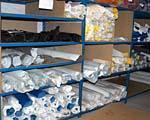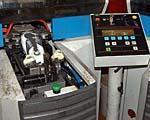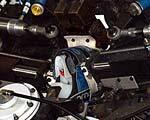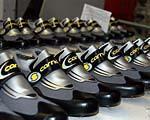

A Cyclingnews special sponsorship feature
Hopping into Carnac Sport - Gesté, France
Carnac's History
Nestled in the tiny town of Gesté, about a half hour drive from Nantes near the west coast of France, is the home of Carnac, a family-owned and operated cycling footwear company. Carnac is a small operation, focusing its attention on limited quantities of high quality cycling footwear rather than mass-market production.
Carnac was founded as a small [non-cycling] shoe company in 1949, but as they faced the economic realities of a small company, the firm decided to dedicate itself to a specific domain: cycling footwear. With 30 years now of focus area, Carnac has established itself as one of the top manufacturers of quality cycling footwear and is now the choice of more than 50 professionals in the European peloton.
With the introduction of clipless pedals in the mid 1980s, Carnac seized the moment and created the first shoes with cleats directly attached to the soles via an insert system. In 1989, the company patented its UCS Interchangeable Insert system, and later patented several other shoe components, including variable sole stiffness through interchangeable bridges. Carnac also entered the highly competitive mountain bike shoe market around 1990.
Unlike big players like Shimano and Nike, Carnac manufactures virtually all of its products in its Gesté facility, with the exception of its free rider mountain bike shoes and smaller accessories such as shoe covers, gloves, etc, which are contracted out to a larger production company.
Carnac Today
 |
Deep in the heart of the Pays de la Loire region of France, Carnac has 45 people working at its Gesté factory. Carnac shoes are sold worldwide, and despite the local identity, exports account for 70 percent of the firm's sales, vs. 30 percent in France. Among the export nations, the United States is the largest customer, with 10 percent of shoe sales, followed by other European markets, Australia, New Zealand, Japan, and South Africa.
In France, as in Spain and Germany, Carnac sells their shoes direct to retailers, while throughout the rest of the world, sales are handled through importers in each country. Road cycling shoes account for 80 percent of Carnac's total production, while tri and mountain bike shoes make up the remainder. The exception to this rule is in Germany, where Carnac sells 70 percent MTB shoes and only 30 percent road. The success of riders like Greg LeMond who wore Carnac helped kickstart the export business in the early 1990s.
Sponsorship of top riders is important to Carnac, but in the face of big companies with bigger budgets, Carnac relies on the fact that many riders actually choose their shoes due to quality and comfort. America's best-known proponent of Carnac now is George Hincapie of the US Postal Service team, along with fellow American Christian Vandevelde. Other riders sponsored by Carnac include Cédric Vasseur, Christophe Moreau and French champion Didier Rous. Undoubtedly, the Carnac name received its biggest boost when three-time Tour de France winner Greg LeMond adopted the brand as his own. LeMond always had more than his share of problems finding adequately comfortable shoes in his racing days, and on the eve of the French season opener one year, he placed a call to Carnac head George Pohu with the hope of finding the right shoe for the job. Pohu then flew to Marseille to meet LeMond and get him set up with several pairs, thus beginning a strong relationship that typified Carnac's efforts to glean feedback from professionals and provide a tailored product. Pohu recounted with pleasure stories of LeMond's visit to the Gesté factory, where he treated the employees as if they were old friends, asking questions and offering suggestions in the laid-back manner that won him the affection of France's cycling fans.
 |
Aside from feedback from its professional contacts, sponsored or otherwise, Carnac relies on a small group of product wear testers to gauge the performance of their shoes. Five loyal cyclists in France regularly test each type of shoe (road, MTB, touring, etc.) over extended periods of time and in all conditions. Because racing is not the only objective for Carnac; the company places ample importance on the comfort and reliability of a shoe destined for use in a variety of situations, including touring, where plenty of walking that may come with the territory of riding to discover towns or countryside.
By subjecting their shoes to constant use and carefully monitoring their longevity, Carnac's designers are able to avoid any major flaws before the shoes hit the market. In-house product checks are also standard procedure at Carnac, and at the end of every week a random sample of five to ten pairs of shoes are set aside to test for defects or variations in the materials used.
How Carnac shoes are made? One pair at a time.
 |
Despite its relatively small size as a production facility, Carnac still functions with both efficiency and quality in mind, dividing the various tasks of shoe construction - and there are many - between several employees and mirroring a larger-scale production style. There are three primary phases to Carnac's manufacturing process: cutting of leather and other materials, construction of the individual components and final assembly. There can be between fifty and eighty different pieces to a given shoe model, and Carnac manufacturers just about all of the components in-house with the notable exception of the soles. The injection-molding process, both space and time-consuming, is handled by another French firm in the region.
The raw materials for Carnac's shoes are kept in the basement of their Gesté factory, where the primary material, genuine leather, is cut into the appropriate shapes for stitching of the shoe uppers. Leather, typically imported into France and dyed by a local tanner, sits waiting in rolls designated for various Carnac shoe models and parts. Piles of already cut upper parts accumulate next to the cutting machine, waiting for the next step in the production line.
 |
Back upstairs, several employees work with sewing machines, stitching together the various flaps and folds of the shoe upper and trimming excess material. This is a critical step in the process, which includes careful placement of a special material in the toe of the shoe which, when heated, is molded and then hardened into the stiff 'toe box'. A similar process is used in the heel of the shoe, providing stiffness where necessary and leaving the middle and top portions of the shoe flexible for comfort and proper size adjustment. The next step is when the shoe really starts to take shape. Two fairly sizeable machines are used, one for the front and one for the heel, to mold the leather uppers around the inner sole of the shoe. Heat, plenty of well-timed pressure, and just the right amount of glue are used to wrap the uppers around the plastic moulds (lasts) that provide Carnac's typical foot shape. Once again, excess material is cut from the sole, glue is wiped from the leather, and what now looks like a shoe is almost ready for the stiff nylon sole to be attached.
Needless to say, the (almost) final step of gluing the nylon sole to the upper is the most important step in assembly. Misaligned or poorly fixed soles will ruin a shoe, and for a shoe to last through steady use for many years, the bond has to be just right. For this reason, Carnac has invested in a special machine to accomplish this task.
 |
Glue is applied by hand to the bottom of the shoe and to the nylon sole, but the bond is not created right away. The soles can sit as the glue dries in order to create a batch of shoes ready for gluing in one session. The fixing machine then reheats the glue on both parts of the shoe to just the right temperature for an effective bond, and in the heat tunnel, provides perfect alignment of the two halves, minimizing irregularities and misalignment. Once the two parts become one, the shoes are placed in yet another machine which applies the force necessary to make this bond a permanent one. With the shoe essentially complete, final cosmetic touches are made and quality checks are performed before the shoes are boxed and sent back downstairs to Carnac's expanded storeroom where they are readied for shipping.
Focus On The Market
In the end, Carnac's goal is to respond effectively to what the cycling shoe market demands. As a smaller company, flexibility is more often possible when preparing shoes for specific markets. For example, customers in the USA prefer darker, more conservative colours, so Carnac is able to create specific models and/or colour schemes for the just for the shoes it exports there, while providing different versions in Europe and elsewhere. Size ranges can vary by market as well, again depending upon demand.
Carnac's top shoe for 2004 is the Quartz, featuring a soft and resistant kangaroo leather upper, four fibreglass reinforced Velcro straps, Carnac's tri-vector ankle belt and their new pre-moulded Carnac Chrono inner sole. Quartz model has the UCS3ev outsole, compatible with all road pedals available on the market via inserts and with Carnac's patented sole stiffener bridges that enabling the user to vary the rigidity of the sole as needed.
A new model for Carnac in 2004 is the lightweight Silex model, which uses the SMC indexed buckle system and two Velcro straps for closure on a comfortable neoprene upper and carbon adaptor plates and stiffening bar mounted on a UCS3ev outsole.
The quality and comfort evident in each pair of Carnac cycling shoes reflect the consummate care and artisan tradition that Mr. George Pohu and his family put in each and every pair of shoes that leave their small factory in the French countryside.
Photography
Images by Chris Henry/Cyclingnews
- The main manufacturing room at Carnac's Gesté, France facility
- Rolls of leather and other raw materials are stored downstairs
- The leather punch gets the process started, cutting the various pieces necessary in different sizes
- The different components of the shoe uppers are stitched together
- The stiff toe and heel sections are molded around shoe lasts by two separate machines
- There's a shoe in there somewhere
- A combination of heat and pressure are applied to begin to form the solid shoe shape
- Machines are calibrated with a program for each shoe size and model
- The shoe upper is wrapped around the insole, after which excess material and glue are trimmed
- An order of completed shoe uppers ready to have their soles glued
- Nylon soles stacked and waiting
- One of Carnac's major investments: A machine to precisely regulate glue temperature and alignment
- After the soles are glued, more pressure is applied to make the bond permanent
- Finished products are sent to the store room, ready for shipping around the world